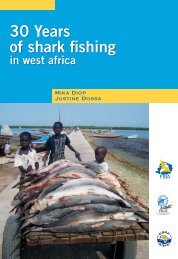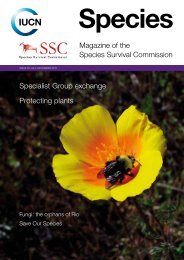Kyne & Simpfendorfer.. - Shark Specialist Group
Kyne & Simpfendorfer.. - Shark Specialist Group
Kyne & Simpfendorfer.. - Shark Specialist Group
Create successful ePaper yourself
Turn your PDF publications into a flip-book with our unique Google optimized e-Paper software.
Over the past few years, AFMA has introduced management for deepwater sharks within the<br />
SESSF. In 2003, trip limits were first imposed for landings of Centrophorus in<br />
Commonwealth waters, although the landing of mid-slope deepwater dogfishes was largely<br />
unregulated until 2005. However, from 2003 the landing of dogfishes (including mid-slope<br />
species) required the landing of both the liver and carcass so that accurate landing information<br />
may be obtained. Due to the difficulty in accurately identifying many deepwater dogfish<br />
species, AFMA introduced a ‘basket’ quota management system for the SESSF in 2005. This<br />
‘basket’ included various species of mid-slope dogfishes, many considered ‘discard’ species<br />
and the quota system set a Transferable Allowable Catch for 2005 and 2006 at around half the<br />
reported 2004 catch (200t). <strong>Shark</strong> species covered under this quota are shown in Table 3.2.<br />
Note that the quota does not include Squalus dogfishes (outer shelf and upper slope species),<br />
known locally as 'greeneye' sharks (Squalus megalops, S. mitsukurii and S. sp. F) and catches<br />
of these remain unregulated. Centrophorus spp (upper slope species) remain managed under<br />
individual trip limits.<br />
Landings data for 'deepwater sharks' (i.e. 'mid-slope' species) from all Sectors of the SESSF,<br />
provided by AFMA are shown in Figure 3.3. Landings peaked in 2002–2004 before the quota<br />
was introduced. A bycatch-only TAC of 22t has been introduced for 2007 as a precautionary<br />
management measure. The data provided by AFMA are based on Catch Disposal Records and<br />
the reliability of this data is questionable, particularly prior to 2000 when the Catch Disposal<br />
Records were introduced (M. Piasente, pers. comm.).<br />
With a lack of species-specific reporting of catches it can not be determined from the industry<br />
data presented by Daley et al. (2002) which species have been most affected. This<br />
information, however, can be drawn from fisheries-independent surveys undertaken on the<br />
NSW upper slope. Graham et al. (2001) compared catches of chondrichthyans in three areas<br />
of the upper slope off NSW at depths of 200–605m from standardized surveys undertaken in<br />
1976–1977 and 1996–1997. A summary of changes in chondrichthyan populations is given in<br />
Table 3.3. The largest declines occurred amongst the Centrophorus species; C. harrissoni and<br />
C. cf. uyato taken in 1996–97 at 0.3% of the 1976–77 catch level, and C. moluccensis at 1.6%<br />
of 1976–77 levels. Changes in relative abundance of greater than -90% were also<br />
demonstrated for Heptranchias perlo, Squalus mitsukurii, S. sp. F, Squatina sp. A and<br />
Hydrolagus ogilbyi. Deania quadrispinosum and skates (Dipturus spp) declined by >80%.<br />
The only chondrichthyan to show an increase in relative abundance was Squalus megalops,<br />
increasing by 18% across the three study areas. This is an abundant small dogfish, also<br />
common on the outer shelf and likely to be recruiting from there to the upper slope (Graham<br />
et al. 2001). It may also have benefited from the decline of other species. It is clear that two<br />
decades of intensive trawl fishing by the SETF caused the collapse of chondrichthyan<br />
populations on the upper slope off NSW. Continued exploitation after 1996 and targeting of<br />
deepwater sharks on the 'mid slope' (650–1200m) added to the pressures already faced by<br />
these species. It is also important to note when considering catch data that localised<br />
extirpations for many mid-slope species may have gone unnoticed due to vessels moving<br />
from seamount to seamount during fishing operations.<br />
Considering the productivity analyses undertaken in Section II of this report, populations of<br />
these species, particularly the overexploited Centrophorus spp, will take considerable time to<br />
recover. A recent ban on commercial trawling at depths >700m in the SESSF (>750m in the<br />
Great Australian Bight) should have significant conservation benefits for deepwater<br />
chondrichthyans (Department of Agriculture, Fisheries and Forestry media release<br />
DAFF07/005A, 29 January 2007). However, while a bycatch only TAC is in place for<br />
'deepwater sharks' (mid-slope species), ongoing fishing pressure on the upper slope will<br />
continue to impact some of the most unproductive shark species (e.g. Centrophorus) through<br />
bycatch.<br />
127
















